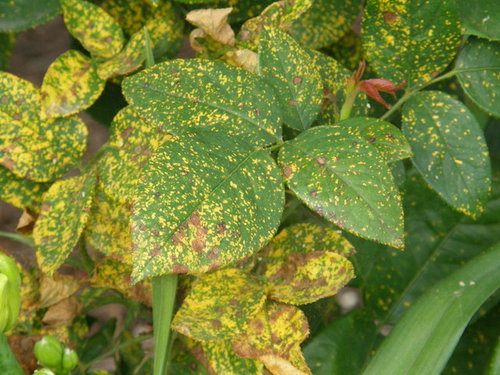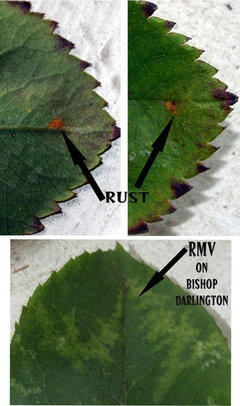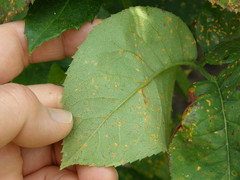Pictures of Rose Moisaic Virus (RMV)
strawchicago z5
10 years ago
Featured Answer
Sort by:Oldest
Comments (54)
dublinbay z6 (KS)
10 years agolast modified: 9 years agostrawchicago z5
10 years agolast modified: 9 years agoRelated Discussions
rmv
Comments (5)Without seeing it in person, I would say that this appears to be rust. The black dots look more like mold. These are probably old leaves, hanging on as some do, even tho they are fairly senile. You might ought to strip them from the plants. In my experience, in California, signs of Rose Mosaic Virus are most likely to be noticed in the spring. This: is the most-common sort of symptom (this is a leaf from 'Altissimo') however, there can be other sorts of virus, and different symptoms. Jeri...See MoreRMV free Reine des Violettes!
Comments (80)that in Graham Stuart Thomas' book on antique roses he specifically mentioned that RDV was in his mind the bluest rose he had ever seen, and that it was notably more "blue" than many of the modern so-called "blue" roses. Obviously since RDV's coloring varies a lot that "blue" only shows up when it's growing in the right soils, however Thomas must have seen it because he wrote that he often wore RDV as a lapel flower to rose functions to remind people that the rose existed and that it could be an unusually "blue" rose....See Moreworried about rose mosaic virus (RMV)
Comments (25)This April 2009 "University of Georgia Agricultural Extension article" is of interest because it does NOT mention the confusing, misleading term "RMV" and DOES mention spread by prunning and insects: "Viral Diseases There are several viral diseases of roses. Most of these maladies are transmitted to non-infected plants through vegetative propagation processes used by commercial rose producers or through pruning. There is some evidence that at least two of these viral diseases are transmitted to other plants by insects or spider mites. Viral infected roses tend to be less vigorous, are more susceptible to other diseases, and are less likely to tolerate environmental stresses as healthy plants do. There are at least six known viral diseases of roses. Yellow and green mosaic patterns, leaf distortion and ring spots are possible symptoms of virus infections. (Figure 12) Others that exhibit viral-like symptoms have not been linked to a particular virus. It is not unusual to encounter plants infected with more than one virus. Also, such occurrences usually cause problems in positive identification. Some chemical toxicities and nutrient deficiencies express symptoms similar to those caused by viral diseases. Removing severely infected plants may be the only solution. Preventive measures to prohibit the spread of viruses include disinfecting pruning shears when moving from one plant to another, and a good insect control program is a must. Also, buy plants that are apparently healthy and exhibit no peculiar foliar symptoms (Figure 13)." ----------------------------------------------------- The 2010 University of California Davis -Ventura County extension article on rose virus also does not use the term "RMV" and also discusses pruning as a means of spread: http://ceventura.ucdavis.edu/Coastal_Gardener/Rose_Virus.htm Here is a link that might be useful: U. of Georgia article...See MoreRose Mosiac Virus @ K&M Roses
Comments (12)Frank- No, you don't have to start all over. What variety did you get from Mr. Mills, if you don't mind me asking? Not everything I've ordered has been infected, so you might be ok. Even if, by chance, the one you ordered does have it, it shouldn't be a problem for you as far as the disease spreading. I just read an article published on the ARS by Malcom Manners stating that the only way of transmission is through grafting. Some people go to the extreme and dig the plant up and burn it. I don't see any point in this as I've never had it spread from one rose to another. The biggest problem for me is that they just don't grow like a normal rose. Much less vigor, flower size distortion, color distortion, and winter tenderness. Also very hard to exhibit an RMV rose unless it isn't showing. Even then you run the risk of someone taking your rose home from the show to root it. My advice: keep it until you find a clean version of it. It may still throw off some nice flowers and grow ok for you. Then again, it may be lackluster. Either way though, DON"T start over! Good luck with your new rose garden!! Kentucky Rose- Yea, the roses had it upon arrival. I didn't plant them in the ground. I ended up planting them in pots until I can get replacements for them. I didn't want to take up good spots in the ground for sick plants so I just potted them up. They are growing, just slower than the rest. I have exhibited a rose with RMV one time. I actually won Princess with her at the Tenarky Districts last year, in fact. The Variety is Bugatti (do not buy it from Mr. Mills!) and it's one of the few that doesn't seem to show symptoms much. But, like I said before, it just generally lacked vigor and I was always wondering how much better she really should be. Just seems kind of pointless to me. I had thought about just paying Mr. Mills and being done with him but the more I thought about it the more it angered me. How many people does he get this over on and how many people just say to hell with it and just pay him? Not doing it this time. Last time I gave him nearly 550 dollars just to have roses I already paid for show symptoms halfway through the season. Half the first ordered showed immediately, and the other half started showing up throughout the summer. I decided he wasn't taking me to the cleaners this time around....See Moredublinbay z6 (KS)
10 years agolast modified: 9 years agostrawchicago z5
10 years agolast modified: 9 years agohenry_kuska
10 years agolast modified: 9 years agostrawchicago z5
10 years agolast modified: 9 years agoroseseek
10 years agolast modified: 9 years agoroseseek
10 years agolast modified: 9 years agoseil zone 6b MI
10 years agolast modified: 9 years agostrawchicago z5
10 years agolast modified: 9 years agostrawchicago z5
10 years agolast modified: 9 years agojacqueline9CA
10 years agolast modified: 9 years agoKippy
10 years agolast modified: 9 years agojerijen
10 years agolast modified: 9 years agostrawchicago z5
10 years agolast modified: 9 years agojerijen
10 years agolast modified: 9 years agostrawchicago z5
10 years agolast modified: 9 years agoroseseek
10 years agolast modified: 9 years agostrawchicago z5
10 years agolast modified: 9 years agostrawchicago z5
10 years agolast modified: 9 years agoroseseek
10 years agolast modified: 9 years agostrawchicago z5
10 years agolast modified: 9 years agojerijen
10 years agolast modified: 9 years agostrawchicago z5
10 years agolast modified: 9 years agojacqueline9CA
10 years agolast modified: 9 years agoportlandmysteryrose
10 years agolast modified: 9 years agoportlandmysteryrose
10 years agolast modified: 9 years agostrawchicago z5
10 years agolast modified: 9 years agocatspa_NoCA_Z9_Sunset14
10 years agolast modified: 9 years agoportlandmysteryrose
10 years agolast modified: 9 years agohenry_kuska
10 years agolast modified: 9 years agomalcolm_manners
10 years agolast modified: 9 years agojerijen
10 years agolast modified: 9 years agostrawchicago z5
10 years agolast modified: 9 years agojerijen
10 years agolast modified: 9 years agostrawchicago z5
10 years agolast modified: 9 years agoKippy
10 years agolast modified: 9 years agoroseseek
10 years agolast modified: 9 years agoroseseek
10 years agolast modified: 9 years agostrawchicago z5
10 years agolast modified: 9 years agoroseseek
10 years agolast modified: 9 years agoportlandmysteryrose
10 years agolast modified: 9 years agodublinbay z6 (KS)
10 years agolast modified: 9 years agocatspa_NoCA_Z9_Sunset14
10 years agolast modified: 9 years agojerijen
10 years agolast modified: 9 years agoKippy
10 years agolast modified: 9 years agoroseseek
10 years agolast modified: 9 years agojerijen
10 years agolast modified: 9 years agodublinbay z6 (KS)
10 years agolast modified: 9 years ago












strawchicago z5Original Author